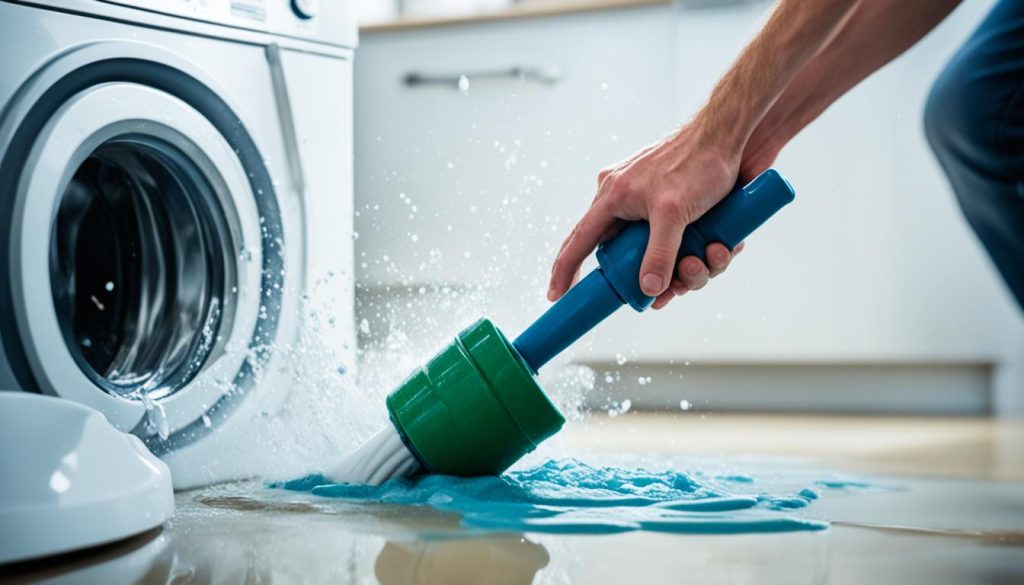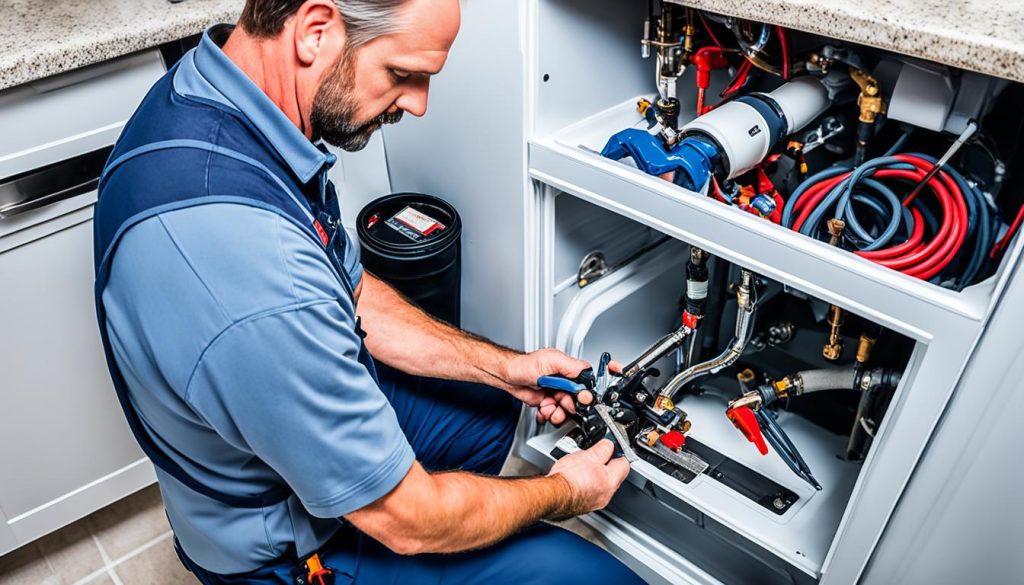Unclog Your Washing Machine Drain Easily!
Did you know that a clogged washing machine drain can lead to costly repairs and damage to your laundry room?
Having a clog in your washing machine drain is not only frustrating but can also disrupt your daily routine. It’s a problem that many homeowners face, and if left untreated, it can cause water backup, unpleasant odors, and even flooding.
But don’t worry, there are simple and effective ways to unclog your washing machine drain without having to call a professional. In this article, I will guide you through various DIY methods to get your drain flowing freely again.
Key Takeaways:
- A clogged washing machine drain can lead to costly repairs and damage to your laundry room.
- Unclogging your washing machine drain is essential to prevent water backup and unpleasant odors.
- In this article, I will guide you through various DIY methods to easily unclog your washing machine drain.
Why Washing Machine Drains Clog and How to Identify the Problem
Understanding why washing machine drains clog is crucial in effectively resolving the issue. There are multiple factors that can lead to a blockage in the washing machine drain, including soap residue buildup, lint and debris accumulation, and even a malfunctioning drain pump. To determine if your washer drain is clogged, keep an eye out for common signs such as pooled water around the machine or a slow-draining washer. To rule out any potential problems with the washing machine itself, it’s essential to inspect the water hoses, vent pipe, and drain line for any blockages or leaks. Once you’ve confirmed that the problem lies in the drain, you can proceed with unclogging it.
Below are some key points that can help you identify a clogged washing machine drain:
- Look for pooled water around the washing machine
- Notice if the washing machine is draining slowly
- Check for unusual gurgling or bubbling sounds
- Observe any water backing up into the washing machine
Inspecting the Washing Machine Components
Before you start troubleshooting the drain, take a few moments to examine the various components of your washing machine. This will help you confirm that the problem is indeed a clogged drain and not something else. Here are the key areas to inspect:
- Water hoses: Ensure that the water hoses are securely connected and free from any kinks or damage.
- Vent pipe: Check if the vent pipe connected to your washing machine is clear and not obstructed.
- Drain line: Examine the drain line for any blockages or leaks.
If you find any issues with these components, address them accordingly. Otherwise, you can move forward with unclogging the washing machine drain.
Using the right unclogging methods can help prevent further damage to your washing machine.
DIY Methods to Unclog a Washer Drain
When faced with a troublesome washing machine drain clog, there are several effective DIY methods you can try before calling a professional plumber. These methods range from simple household ingredients to specialized tools, allowing you to troubleshoot the issue and restore your washing machine’s functionality.
One of the simplest DIY methods is using hot water and baking soda. Start by pouring a pot of boiling water down the drain, followed by half a cup of baking soda. Allow the mixture to sit for a few minutes before flushing it out with a mixture of one cup of vinegar and one cup of hot water. This combination of ingredients can help break down and dislodge any blockages in the drain.
If the hot water and baking soda method doesn’t work, another option is using a commercial drain cleaner. Before proceeding, make sure to read and follow the instructions on the label carefully. These cleaners are specifically designed to dissolve stubborn clogs, providing a powerful solution to your washing machine drain issue.
In some cases, a clog may require more direct intervention. This is where a drain snake or a power auger comes in handy. These tools allow you to physically remove the blockage from the drain. Insert the snake or auger into the drain opening and rotate it gently to break up and dislodge the clog. Be cautious not to damage the drainpipe while using these tools.
Remember, when attempting any DIY method to unclog a washer drain, it’s crucial to prioritize safety. Wear protective gloves and eyewear, and ensure that the area around the washing machine is well-ventilated. If you’re unsure about using any of these tools or techniques, it’s always best to consult a professional plumber.
By trying these DIY methods, you can troubleshoot a washing machine drain clog and possibly save time and money on professional services. However, if your efforts are unsuccessful or if you feel uncomfortable attempting these methods yourself, it’s advisable to reach out to a professional plumber who can provide the expertise needed to resolve the issue.
When to Call a Professional Plumber
If the DIY methods mentioned earlier don’t successfully unclog your washer drain, or if you’re not comfortable attempting them, it’s best to call a professional plumber. A professional plumber has the necessary tools and expertise to safely and efficiently unclog your washer drain, ensuring a thorough and long-lasting solution.
Attempting to fix a clogged washing machine drain without the proper knowledge and equipment can lead to further damage to your washing machine or plumbing system. That’s why it’s important to reach out to a qualified professional who specializes in plumbing services.
A professional plumber will not only unclog your washer drain but also identify any underlying issues that may be causing the clog. By addressing these issues, they can provide a long-term solution and help prevent future drain clogs.
When hiring a professional plumber, make sure to choose a reputable and experienced provider. You can ask for recommendations from friends, family, or colleagues who have had similar plumbing issues. Additionally, check online reviews and ratings to ensure you’re hiring a reliable and trustworthy plumber.
Remember, calling a professional plumber is the best course of action when the DIY methods don’t work or when you’re unsure about handling the situation yourself. By doing so, you’ll save time, effort, and potential costly repairs down the line.
Next, I will provide some helpful tips to prevent future washer drain clogs, so you can keep your washing machine running smoothly.
Tips to Prevent Future Washer Drain Clogs
Now that you’ve successfully unclogged your washer drain, it’s important to take preventive measures to avoid future clogs. By incorporating these simple tips into your washing machine routine, you can keep your washer drain clear and prevent any future headaches.
The first step is to regularly clean the lint trap. This small but crucial task helps prevent lint and debris from building up and causing blockages in the drain. Simply remove the lint trap, clean it thoroughly, and replace it before every load of laundry.
In addition to cleaning the lint trap, using a washing machine cleaner can also help prevent drain clogs. These cleaners are specifically formulated to remove soap scum and mineral buildup that can accumulate over time. Follow the instructions on the cleaner and run a cleaning cycle every month or as recommended by the manufacturer.
Another preventive measure is to run hot water through the drainpipe after each use. This helps flush out any remaining soap residue or debris that may be lingering in the drain. Simply turn on the hot water faucet and let it run for a few minutes to ensure a clear drain.
Lastly, it’s important to be mindful of the items you wash in your machine. Avoid washing large objects such as rugs, comforters, or heavy blankets, as these can cause blockages in the drain. If necessary, take these items to a laundromat with commercial-grade machines or have them professionally cleaned to prevent any potential clogs.
By following these simple tips and incorporating regular maintenance into your washing machine routine, you can prevent washing machine drain clogs and keep your laundry running smoothly. Remember, a little preventive care goes a long way in maintaining the longevity and efficiency of your washing machine.
- Investing Wisely: How Windows & Doors in Boost Property Value and Financial Health - April 24, 2025
- The Financial Impact of Personal Injuries: Why Legal Help Matters for Business Owners - April 16, 2025
- The Hidden Financial Costs of Domestic Assault: What Business Owners Need to Know - April 16, 2025














